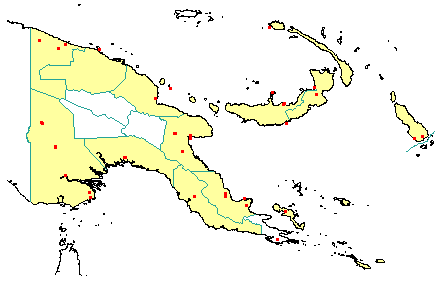
in PNGplants database
PNGTreesKey – Ficus variegata Blume |
Barry Conn (NSW) & Kipiro Damas (LAE).
Guide to trees of Papua New Guinea
Copyright held by the authors, National Herbarium of New South Wales, and Papua New Guinea National Herbarium
Flora van Nederlandsch Indië 245 (1825)
Other Literature: C.C. Berg & E.J.H. Corner, Flora Malesiana, Series 1 347-350 (2005) Fig. 58 (g-l, map 7).
Family: Moraceae
Dicotyledon
Timber Group: Occasional timber species Tradename: Fig
Field Characters: Emergent tree (up to 40 m high) or Large canopy tree; Bole markedly fluted (up to c. 120 cm diam.); straight (bole up to 20 m long) or crooked; buttresses buttresses present (often becoming buttressed with age, up to 2 m high); spines spines absent; aerial roots aerial roots absent; stilt roots stilt roots absent; Bark grey (in patches), pale red, or green, slightly rough or smooth, slightly peeling or sometimes pustular, lenticels irregular; Subrhytidome (under-bark) green; less than 25 mm thick, 8.0-14.0; bark blaze consisting of one layer; faintly to non-aromatic; outer blaze white, yellow (pale (cream-coloured), or pink, with stripes (white); inner blaze yellow (pale (cream-coloured), white, or pink, with stripes (white); bark exudate (sap) present, white/milky, flowing, colour not changing on exposure to air, sticky; terminal buds enclosed by leaves.
Indumentum: Complex hairs absent; stinging hairs absent; mature twig indumentum (hairs) absent or present, hairs sparse (with white appressed hairs).
Leaves: Leaves spaced along branches, spiral (leaves occurring singly at a node and arranged spirally up the branchlet), simple (a leaf composed of a single blade); petiole present, not winged, attached to base of leaf blade, not swollen; leaves broadest below middle or broadest at or near middle, 6.0-20.0 (-35.0) cm, 2.0-10.0 (-15.0) cm; symmetric, entire or coarsely serrate to dentate (toothed), not dissected or lobed, sub acute, obtuse, or acuminate, venation pinnate, secondary veins open, prominent, intramarginal veins absent; leaves lower surface pale green or green, upper surface dark green (glossy (to subglossy), indumentum (hairs) absent (upper surface) or present (on lower surface and on veins of upper surface), indumentum (hairs) dense or sparse (hairs very short); absent; domatia absent (but with cystoliths on lower surface only); stipules absent.
Flowers: Inflorescence on the trunk or branches, flowers on an unbranched axis (flowers in syconium/fig), cones absent; flowers unisexual, unisexual with male and female flowers on the same plant, not stalked or stalked (shortly (flowers shortly pedicellate; synconium/fig with peduncle usually 10-60 mm long), flowers with one plane of symmetry (male and female flowers), with many planes of symmetry (synconium/fig), or completely asymmetric, 1.5-2.0 mm long, diameter small (up to10 mm diam.) (c. 1.5 mm diam.); perianth present, with all sepals and/or petals (hence tepals) similar (membranous); 3-4, free or some or partly joined (shortly at base); stamens 1 (male flowers), present, free of the perianth; ovary superior, carpels solitary; styles absent (male flowers) or solitary (female flowers), 1.
Fruits: Infrutescence arranged on unbranched axis (syconium/fig), fruit 10.0-35.0 mm long, (15.0-) 20.0-30.0 (-50.0) mm diam., red (pink to mid red) or green (possibly mature), not spiny, fleshy, syconium (fig), indehiscent, achene or syconium (fig); seeds 100, barely visible (to 1 mm long) (up to 1 mm long), not winged, broad (as wide as long), seed less than 1 mm diam. (c. 0.5 mm diam.).
Distribution: West Sepik, East Sepik, Madang, Morobe, Western, Gulf, Central, Northern, Papuan Islands, New Britain, New Ireland & Bougainville.
 | Botanical records in PNGplants database |